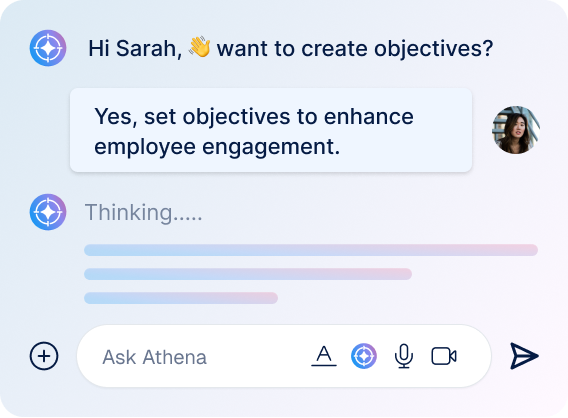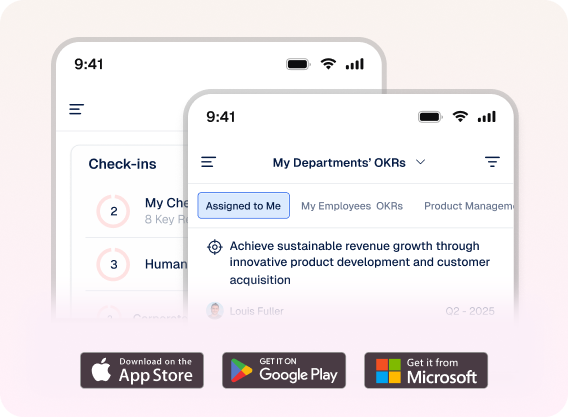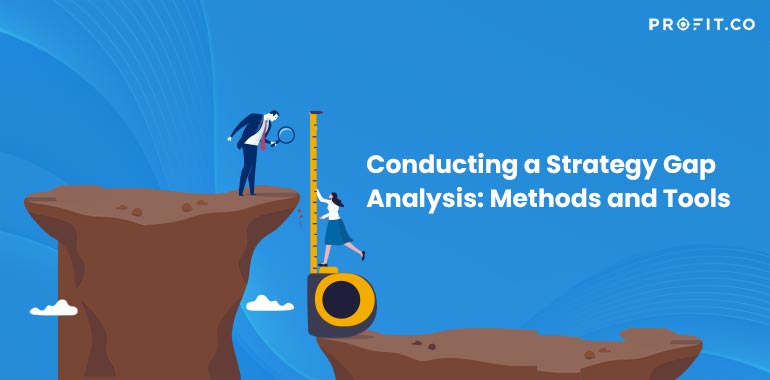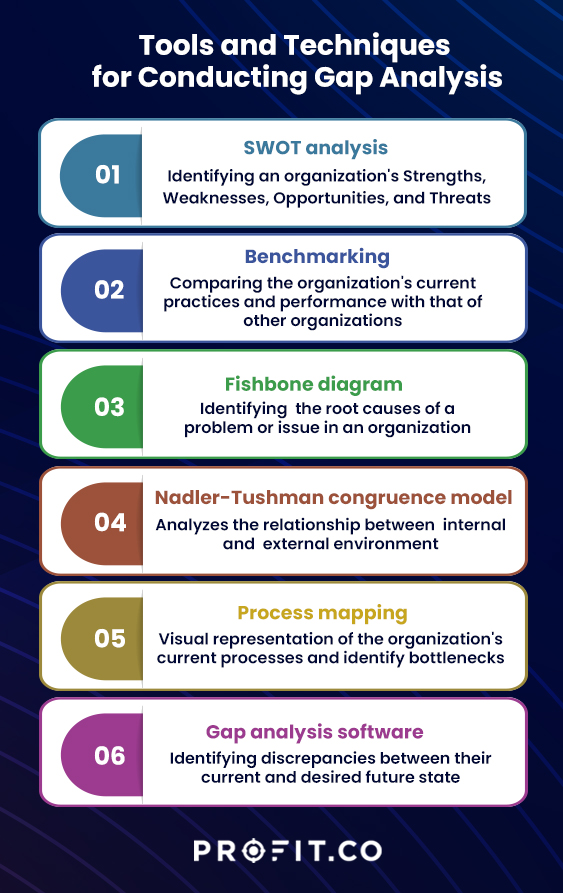Introduction
A question we all ask ourselves frequently, both personally and professionally, is whether we are making progress. We define our success by assessing where we are today against the goal we had set for ourselves when we started. Considering this measurement is critical, you need to measure the progress you have made or lack thereof. A tool that organizations use effectively to measure progress or identify shortfalls or strategic gaps is strategy gap analysis. Strategy Gap Analysis compares an organization’s current strategy, capabilities, and resources with its goals and objectives and helps them identify areas where they are on target or falling short.
What is strategy gap analysis?
Strategic gap analysis is a process that helps organizations identify discrepancies between their current state and their desired future state, as well as the steps they need to take in order to bridge that gap. It involves assessing where they are today with regard to the capabilities and resources, benchmarking against the desired state and identifying areas where there are discrepancies or gaps. It can be a useful tool for organizations trying to identify and address weaknesses in their current strategy or looking to make changes in order to achieve specific goals.
When do companies undertake strategy gap analysis?
There are several reasons why companies choose to do a strategic gap analysis:
- To identify weaknesses, if any, in their current strategy and to take timely action: By comparing their current state with their desired future state, companies can identify areas where their strategy is not effective, and take steps to address those weaknesses.
- To make changes in their plans to achieve specific goals: Companies may use strategic gap analysis to help them identify the steps involved in strategic planning and take corrective measures to achieve specific goals or objectives.
- To respond effectively to changes in the external environment: Changes in the external environment, such as shifts in market conditions or new regulatory requirements, may require companies to change their strategy to remain competitive. Strategic gap analysis can help companies identify the areas they need to adapt to meet these new challenges.
- To improve performance: Companies may use strategic gap analysis to identify opportunities for improvement and develop a plan for achieving those ,strategic priorities.
Strategic gap analysis is a valuable tool for companies looking to make changes to achieve specific goals or improve their overall performance. It can be undertaken at any time, but it is often most useful when a company is facing significant challenges or changes or is looking to make major shifts in its strategy.
Reasons for strategy-execution gap
When long term planning is under process and strategies are being formulated to achieve the numbers set, organizations or teams often go for their best bet ever. Very little thought is put in at this stage to the execution part. Who will execute this strategy, is it complex for people to understand and implement, and is it possible to translate the big strategy into actionable points for each team member involved in the execution? You should explain the reason behind this strategy, how every member can contribute, what difference they will make to the company, and the desired outcome. If these points are not clear, then gaps appear. Book a free demo with our team to learn more about how OKR software can help bridge your strategy execution gap and optimize your organization’s performance!
Six key Benefits of doing a Strategy Gap analysis
There are multiple benefits in undertaking a strategy gap analysis. We will list a few examples of how organizations use gap analysis to its advantage.
Best utilization of resources: For example, if you are a small business with limited resources, then a strategy gap analysis can help you assess your resource requirements and allocate them most effectively to achieve your goals.
Identification of operational improvements: Project managers often use strategy gap analysis to assess actual business performance, identify gap areas and develop an action plan to improve performance levels.
In hiring and best utilization of work talent available: Gap analysis is often used by HR teams to identify the current skillsets within an organization, map new requirements, identify gap areas and hire new talent if required to meet the business objectives.
To improve customer service standards: Customer service teams often use gap analysis to identify the discrepancies between their current customer service levels and the desired future state. It often throws up important information in a company’s response time, whether the current number of trained customer service representatives are enough to meet the desired outcomes, whether to invest in more advanced customer service technology to keep with market demands etc.
To identify discrepancies between the current sales and marketing strategy and its desired future state: The gap analysis often reveals whether a company needs to improve its online presence, invest in more targeted advertising, develop a more comprehensive loyalty program, etc., to achieve the targets set.
To identify market gaps: This is often done to uncover new market opportunities. This can help companies identify new markets to enter, or even new products rolled out to fulfill existing demand.
4 Important Steps to follow while doing a strategy gap analysis.
There are no clear-cut guidelines to follow when doing a gap analysis. Every organization develops its framework based on what they want to measure.
Identify specific areas that you want to analyze The first step is to identify the areas that you want to analyze. Is it manpower, product offerings, performance or profit? This is just an indicator and not a complete list in itself.
For eg, Companies may want to assess their manpower requirements for an upcoming project vis-à-vis the current resources available. It could be concerning the talent and skillsets required to work on future projects or the number of people needed to handle some task. For eg. The optimal size of the customer service team needed to service the customer service effectively calls that come in daily.
Companies may want to analyze and identify gaps in the performance of an individual, a team or the entire company. Or a gap analysis could be done to identify gaps in its product offerings vis-à-vis what is in demand in the market.
Evaluate current status of the organization This involves assessing the organization’s current position against the goal set. Let us take the manpower requirements gap analysis discussed in the last section to explain this further. You are signing on a new project which requires a team to be positioned at the client’s site. The skill sets required are varied. You have signed the dotted line and are expected to start delivering on the project in a month. You now need to do a gap analysis of the manpower at your end and the skills sets required to get the project up and running. What are the current projects running, the team allocation for the existing projects, and are extra resources at your end that can be put into the new project? What are the skillsets required? Do you have them internally, or do you need to hire new people? What is the budget allocation, and what is the time frame available for execution? When you answer all these questions systematically, you arrive at your organization’s current status.
Identify the desired state Be as specific and transparent as possible on what the desired state is. Put numbers to the desired outcome so that it is clear and executable. For example, our organization will need 10 employees stationed at the client site within a month with the following skill sets and experience levels. They will contribute xx% to the total billing goal set and the expenses we can incur for putting this team is place is Rs.xx.
Bridge the Gap Now that you have assessed your current state and have identified the desired state, the next step is to bridge this gap for example of the 10 employees that you need to station at the client’s site you realize you have only 3 team members who have the skills sets required and with the necessary experience levels who can be allocated for the new project. The rest 7 will have to come in from external pool. Put an action plan is place to bridge the gap. Do you notify these openings within your sister organizations and open up lateral entry opportunities, do you hire an external staffing organization to fill the gap from outside? These action plans need to be drawn up as the next step forward.
Tools and Techniques used for conducting gap analysis
There are several tools and techniques that can be used to conduct gap analysis. Some common ones include:
SWOT analysis: This involves identifying an organization’s Strengths, Weaknesses, Opportunities, and Threats. A company lists down its internal strengths and weaknesses. This gives them an opportunity to examine how they can leverage their strengths to overcome weaknesses and neutralize threats, and how to capitalize on opportunities to mitigate threats and eliminate weaknesses.
Benchmarking: This involves comparing the organization’s current practices and performance with that of other organizations, in order to identify areas where it is falling behind or where it has the potential to improve.
Fishbone diagram: A fishbone diagram is a tool used to identify the root causes of a problem or issue. It is also sometimes called a cause-and-effect diagram or an Ishikawa diagram, after its creator, Kaoru Ishikawa. In the context of strategic gap analysis, a fishbone diagram is used to identify the root causes of discrepancies between an organization’s current and desired future state. For example, if an organization is struggling to achieve its goals, a fishbone diagram could be used to identify the underlying causes of that struggle.
To create a fishbone diagram, you draw a large “fish skeleton” on a piece of paper or whiteboard, with the head on the left and the bones branching out to the right. The problem or issue at hand is written at the head of the skeleton. The skeleton’s bones represent the different categories of potential causes, such as people, equipment, processes, and materials. Within each category, you can then list specific reasons that may be contributing to the problem.
Once the diagram is complete, you can use it to identify the root causes of the problem and develop a plan for addressing those causes to solve the problem. Fishbone diagrams can be a useful tool for identifying the root causes of discrepancies in strategic planning and execution and developing a plan to bridge the gap between an organization’s current and desired future state.
The Nadler-Tushman Congruence model: This framework helps organizations understand the relationship between different elements of their internal environment, such as their structure, processes, and culture, and their external environment, such as the market, competition, and regulatory environment. It helps organizations identify discrepancies or “gaps” between these elements and develop a plan to bridge them.
It is particularly useful in strategy gap analysis as it helps organizations understand how their internal factors align with their external environment and the gap between them and their goals. The model suggests that for organizations to be successful, these elements must be aligned and congruent. This helps organizations identify areas of incongruence and take steps to realign them to achieve their goals, which helps to bridge any existing gap.
Process mapping: This involves creating a visual representation of the organization’s current processes to identify inefficiencies or bottlenecks.
Gap analysis software: Several software tools are specifically designed to assist with gap analysis. These tools can help organizations identify discrepancies between their current and desired future state and provide recommendations for addressing those gaps.
The choice of a specific tool or technique will depend on the needs and goals of the organization. It may be helpful to use a combination of different tools to comprehensively understand the organization’s current state and the steps needed to achieve its desired future state.
How to bridge the strategy execution gap using OKRs
One way to bridge the execution gap is by using OKRs. OKRs help set specific, measurable goals that align with the identified gap. The key results expected should be measurable for tracking progress. The company should also frequently review and refine the OKRs to ensure they are aligned to close the gap and execute the overall strategy. OKRs and strategy are essential for the success of any business.
OKRs have helped lead us to 10x growth, many times over. They’ve kept us on track when it mattered the most
An example of how OKRs can be used to bridge the strategy execution gap of an organization in one year.
Objective: Increase market share in the retail sector
Key Results:
- Increase the number of retail outlets by 20%
- Increase online sales by 30%
- Increase market share by 5%
In this example, the objective is aligned with the overall strategy of increasing market share in the retail sector. The key results are specific, measurable, and time-bound, allowing progress to be tracked. The OKRs are assigned to a specific team responsible for achieving the results, and regular monitoring and feedback are provided to ensure progress toward achieving the overall strategy.
This OKRs example illustrates how aligning objectives and key results with the overall strategy, clear communication, and clear assignment of responsibilities can help bridge the strategy execution gap by providing measurable and actionable goals and objectives. OKrs play a significant role in efficient strategy execution
Frequently asked questions about Strategy Gap Analysis
What is strategy gap analysis?
- It is a tool used by organizations to identify the gap between their current performance and their desired performance.
- It is a way to measure progress and identify shortfalls in achieving goals and objectives.
- The process involves comparing the current state of the organization to the desired future state and identifying any gaps or discrepancies.
Why is strategy gap analysis important?
- It helps organizations to identify areas where their strategy is not effective and take steps to address those weaknesses.
- It can also help organizations to make changes in their plans to achieve specific goals.
- It helps organizations to respond effectively to changes in the external environment.
What are some common techniques used in strategy gap analysis?
- SWOT analysis, PEST analysis, and gap analysis charts.
When should an organization conduct a strategy gap analysis?
- When they are facing significant challenges or changes.
- When they are looking to make major shifts in their strategy.
- It is important to do so regularly, to align the internal and external environment.
How can organizations use the results of a strategy gap analysis?
- To develop and implement strategies to close the gap and improve performance.
- To identify opportunities for improvement and develop a plan for achieving those improvements.
- To align the internal and external environment through the Nadler-Tushman Congruence Model.
How can an organization ensure that their strategy will be executed effectively?
- Involving all relevant stakeholders in the strategy development process.
- Communicating the strategy clearly and consistently.
- Providing the necessary resources and support for implementation.
- Having clear actionable steps and assigning responsibilities.
- Providing regular feedback and monitoring the execution.
Conclusion
To summarize, strategy gap analysis can be a valuable exercise for organizations looking to identify areas of weakness in their current strategy and take steps to achieve specific goals and improve performance. Once the gaps are identified, organizations can make better use of resources, adapt to changes, and improve communication and alignment among teams. To learn about how OKRs can help with your strategy you can get started on Profit.co completely free today!





